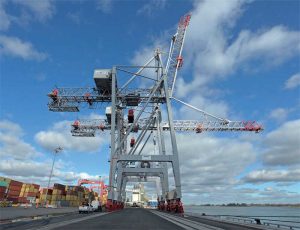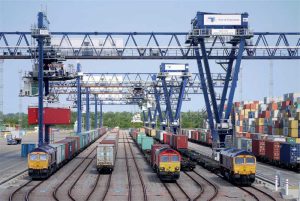Gantry cranes for use at ports are getting makeovers, with new units and retrofitted existing cranes being fitted with automation capability, as well as safety and efficiency upgrades. Daniel Searle reports.
- Liebherr will supply one rail-mounted gantry crane and a ship-to-shore crane to Termont Montreal in Canada.
- Rail-mounted gantry cranes from Liebherr.
Finland-based crane manufacturing giant Konecranes has worked with Fluidmesh Networks—a specialist in wireless systems for security and industrial applications—to devise the first fullywireless automated rubber-tyred gantry (ARTG) crane, say the companies. The companies successfully carried out proof-of-concept testing of the system, which will allow container terminal operators to use remote control and automation with RTGs in the container yard without the need for fibre or cable spools, thereby saving cost and time.
“Many of the newest and largest container terminals have been adopting some level of automation and support for remote operations: from ship-toshore cranes, to horizontal transport, to automated stacking cranes,” says Konecranes. “However, this has not been the case for RTGs, which are widely used in container terminals around the world. Much of the world’s RTG fleet is diesel-powered, and there have been limited options for automating RTGs given the fact that running cables to them is costly and often impractical.”
The automation capability for RTGs is part of Konecranes’s ARTG 2.0 system update, which was in development for over two years, including thousands of hours of field testing, says the manufacturer. The results of the testing show that the system—which uses Fluidmesh MPLSbased wireless technology for low latency and high throughput to the RTGs for control and live-video data—provides over 99.95% uptime in real working conditions.
“We are thrilled to have been given the opportunity to work with a leader like Konecranes and contribute to a system that helps container terminal operators around the world to embrace automation and drive the productivity of their RTGs,” says Cosimo Malesci, Fluidmesh co-founder and EVP of sales and marketing. “Our wireless MPLSbased technology has been proven in many vehicle automation systems around the world where 802.11 WiFi or LTE haven’t been able to deliver. Our focus on seamless roaming, extremely low latency and high throughput wireless networks to drive productivity, safety, and security continues to pay off.”
“We have been impressed by Fluidmesh Wireless MPLS technology since day one,” says Sampo Pihkala, chief system engineer ARTG at Konecranes. “We have been testing many different wireless technologies for crane operations over the last decade and the throughput and reliability delivered by Fluidmesh is unparalleled.”
In Colombo, Sri Lanka, Konecranes Port Services has been working with South Asia Gateway Terminals (SAGT) for several years on a retrofit project involving 28 Doosan and 9 ZPMC RTG cranes in SAGT’s container yard equipment fleet.
Gantry cranes for use at ports are getting makeovers being fitted with automation capability


没有评论:
发表评论